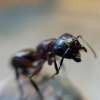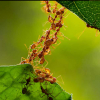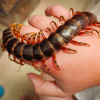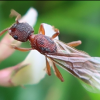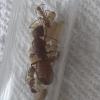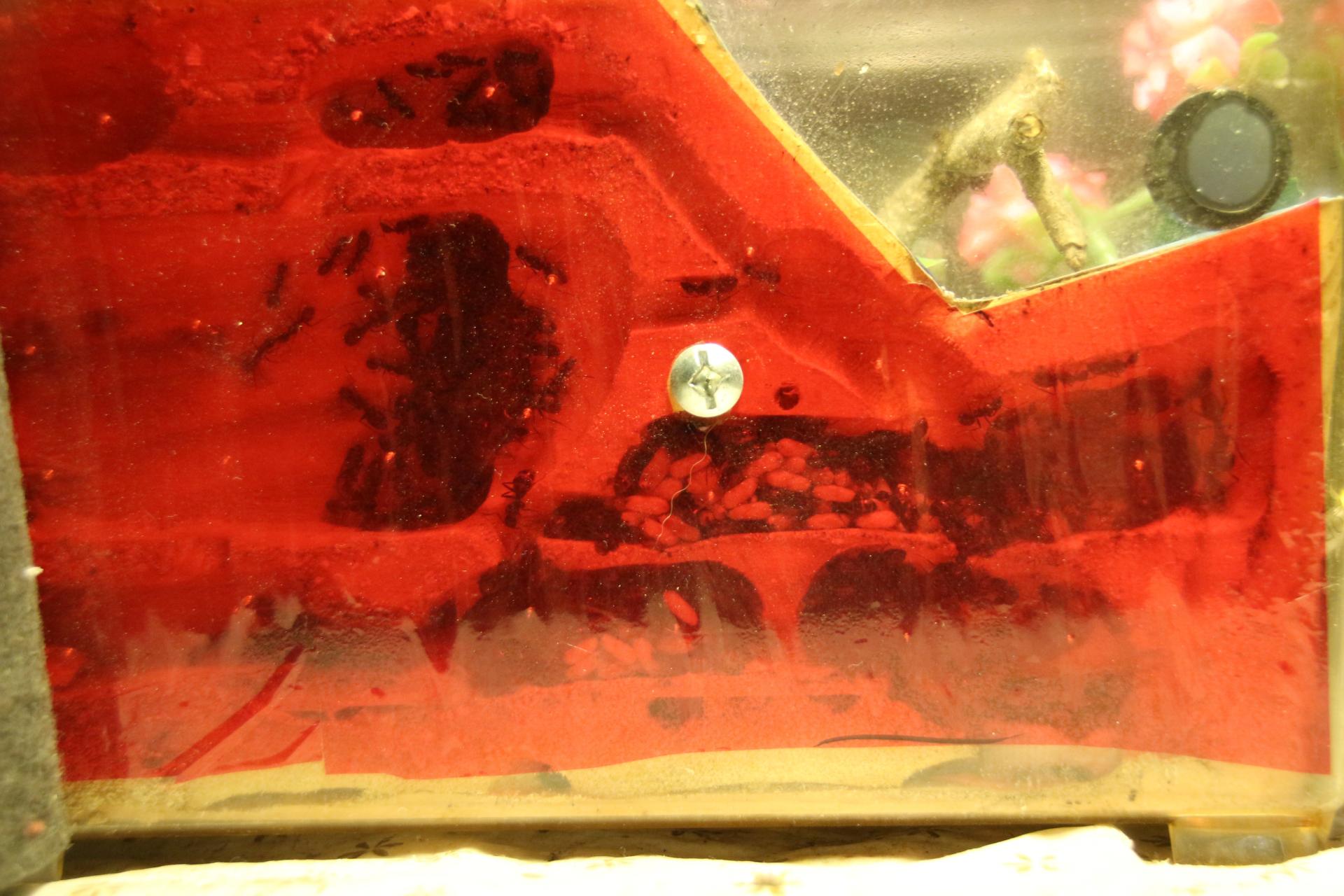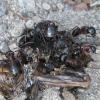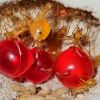- Formiculture.com
- Forums
- Gallery
- Members
- Member Map
- Chat

Is it possible to raise Camponotus in captivity?
Started By
Runner12
, Mar 31 2017 2:44 PM
60 replies to this topic
#41
 Offline
-
Posted August 3 2019 - 9:06 AM
Offline
-
Posted August 3 2019 - 9:06 AM
Lol like I said, I finally got what I wanted so I've been doing any research I can to get a hint of what they require. Hard to really say besides the basics but trying to tame something like ants, in my book at least, has many variables and outcomes that we can not predict. We can only try our best and learn from what we've accomplished.
Just in the almost 2 months I've had this c pennsylvanicus, I've learned alot. She has had her typical handful of nanitics being domesticated. I havent read too much about her future generations, just what to expect in 1 year, 2 years...etc etc. The fact I found a healthy FAT queen to begin with and she managed to get her first workers makes me relieved that I can spend more time examining her. I've seen her go to the food pile in the mini hearth xl and eat more so than by way trophalaxis. She seems very promising
Just in the almost 2 months I've had this c pennsylvanicus, I've learned alot. She has had her typical handful of nanitics being domesticated. I havent read too much about her future generations, just what to expect in 1 year, 2 years...etc etc. The fact I found a healthy FAT queen to begin with and she managed to get her first workers makes me relieved that I can spend more time examining her. I've seen her go to the food pile in the mini hearth xl and eat more so than by way trophalaxis. She seems very promising
Only nature truly knows what is going on. We can only try to scratch the surface of her wisdom.
#42
 Offline
-
Posted August 3 2019 - 10:06 AM
Offline
-
Posted August 3 2019 - 10:06 AM
Reading this thread is very interesting. I’m starting up my first Camponotus colonies this year, so I’m learning. One thing I’ve always aimed for with all my ants is giving them a lot of different insects and spiders for protein. This means wild catching them, which I know has its own risks. The gut microbe part is really fascinating, and I think that’s why Camponotus go nuts for termites.
Edited by ANTdrew, August 3 2019 - 6:45 PM.
- PacificNorthWestern likes this
"The ants are a people not strong, yet they prepare their meat in the summer." Prov. 30:25
Keep ordinary ants in extraordinary ways.
Keep ordinary ants in extraordinary ways.
#43
 Offline
-
Posted August 3 2019 - 10:07 AM
Offline
-
Posted August 3 2019 - 10:07 AM
It’s also fascinating how many big time members on here just vanish after a year or so.
- TennesseeAnts and PacificNorthWestern like this
"The ants are a people not strong, yet they prepare their meat in the summer." Prov. 30:25
Keep ordinary ants in extraordinary ways.
Keep ordinary ants in extraordinary ways.
#44
 Offline
-
Posted August 3 2019 - 2:31 PM
Offline
-
Posted August 3 2019 - 2:31 PM
Prolly wives and husbands getting tired of dodging the area where ants are kept lol
I've read about the gut microbe as well and it just makes me think that when and if my c pennsylvanicus get big enough, I want them to have a travel tube where I have other live insects such as termites, crickets, and beetle larvae dead in different zones along with seeds and sugars. I've witnessed them hunt fruit flies with some success, not as much as my Formica of course, but it's an addition to the future setup. I know they travel, I would like to give them that
I've read about the gut microbe as well and it just makes me think that when and if my c pennsylvanicus get big enough, I want them to have a travel tube where I have other live insects such as termites, crickets, and beetle larvae dead in different zones along with seeds and sugars. I've witnessed them hunt fruit flies with some success, not as much as my Formica of course, but it's an addition to the future setup. I know they travel, I would like to give them that
Only nature truly knows what is going on. We can only try to scratch the surface of her wisdom.
#45
 Offline
-
Posted August 3 2019 - 2:33 PM
Offline
-
Posted August 3 2019 - 2:33 PM
I have a Camponotus modoc colony that was wild caught with 20 ish workers 1.5 yrs ago that has at least tripled in size. They would have grown a lot more had I fed them till they stopped eating.
I think the key with wood dwelling Camponotus is consistent feedings, hibernation, housing, and care. Moving a colony and losing some brood can make a huge impact on Camponotus colonies because it takes so long for brood to develop, which is why I am now trying to limit movement of colonies and let them completely fill up their current setups before doing anything.
I think the key with wood dwelling Camponotus is consistent feedings, hibernation, housing, and care. Moving a colony and losing some brood can make a huge impact on Camponotus colonies because it takes so long for brood to develop, which is why I am now trying to limit movement of colonies and let them completely fill up their current setups before doing anything.
Edited by YsTheAnt, August 3 2019 - 2:34 PM.
- ANTdrew likes this
#46
 Offline
-
Posted August 3 2019 - 6:58 PM
Offline
-
Posted August 3 2019 - 6:58 PM
Yes. Of course I will progressively give them something bigger to live in. I want their focus on colony growth and not exploration. I would say that once my first major comes in (if they come) then I will start to give them more foraging tubes. But until then, it is close proximity. I think that once the queen is safe with majors as guards, they will be less worried about the queen son they can focus on traveling further for different foods and such.
I can only think of what it takes to get a colony as you would see it in the wild. Replicating is futile. This first hibernation with the colony will be the biggest test but given that nebraska had a pretty impactful winter, I'm hoping she was bred with some strong genes
I can only think of what it takes to get a colony as you would see it in the wild. Replicating is futile. This first hibernation with the colony will be the biggest test but given that nebraska had a pretty impactful winter, I'm hoping she was bred with some strong genes
Only nature truly knows what is going on. We can only try to scratch the surface of her wisdom.
#47
 Offline
-
Posted August 8 2019 - 2:17 PM
Offline
-
Posted August 8 2019 - 2:17 PM
Ugh.... this happened to me over the winter too. I lost a formica colony (my favorite). I allowed the water in the test tube run dry. I checked occasionally as well. Just missed it at the wrong time.Soulsynaps I'm sure when he said he neglects colonies it's more that he procrastinates to feed them or doesn't watch them properly over hibernation. This happens a lot, I'm guilty of it.
Mdrogun you're not helping things by commenting like that. I understand he insulted you but this was getting out of hand.
End discussion.
Oh well, but I've got 4 queens this year! We live for another day!
I do have a c.novaeboracensis colony over three years. They're picky eaters. Crickets, sugar water, fresh grasshoppers,
Flies. I had 2 huge majors last year but lost them over the winter. The winter tends to be rough on the colony. This year the colony size is huge 200 but the ants this year are noticeably smaller. I just added a heat cable and it really gets the nest humming. I had many Male alates this year too.
Sincerely
Canadant
Edited by Canadant, August 8 2019 - 2:23 PM.
- Ikerrilove and ANTdrew like this
"You don't get what you want. You get what you deserve".
#48
 Offline
-
Posted July 19 2023 - 4:14 PM
Offline
-
Posted July 19 2023 - 4:14 PM
Reading this thread is very interesting. I’m starting up my first Camponotus colonies this year, so I’m learning. One thing I’ve always aimed for with all my ants is giving them a lot of different insects and spiders for protein. This means wild catching them, which I know has its own risks. The gut microbe part is really fascinating, and I think that’s why Camponotus go nuts for termites.
Are spiders safe to feed to ants regarding pesticides and all? I would love to feed my ants some spiders, but I live next to a golf course and worry a ton about the pesticides they probably use there.
Edited by gs5248, July 20 2023 - 7:29 AM.
#49
 Offline
-
Posted July 19 2023 - 4:57 PM
Offline
-
Posted July 19 2023 - 4:57 PM
I'd asssume if pesticides were an issue the spiders themselves would die from them.
And talking about large colonies - that's the stuff i have to deal with right now.

They made hundreds of them.
It's so much fun picking them off the walls ![]()
- aznphenom likes this
We should respect all forms of consciousness. The body is just a vessel, a mere hull.
Welcome to Lazy Tube - My Camponotus Journal
#50
 Offline
-
Posted July 19 2023 - 6:03 PM
Offline
-
Posted July 19 2023 - 6:03 PM
Starting in the hobby, my first species is Camponotus CA02 so I found this thread VERY interesting. I made a journal on them and started collecting as much information as I can in hopes of success, especially in the long run.
Thanks for the information, everyone ![]()
Edited by BleepingBleepers, July 19 2023 - 10:48 PM.
JOURNAL: Camponotus CA02 - First Time At Ant Keeping CLICK HERE
JOURNAL: Ectomomyrmex cf. astutus - Ant Species #2 CLICK HERE
#51
 Offline
-
Posted July 19 2023 - 10:56 PM
Offline
-
Posted July 19 2023 - 10:56 PM
I don't think most ants really need a day-night cycle. There's a study about a Camponotus colony in a crashed tree and they found that while the temperature outside swung wildly by over 30°C, inside the nest chambers it barely moved a degree. Wood is a ridiculously good isolator, a thick layer of soil even more so. Ants in northern areas also love to nest under stones because these stay warm during most of the night.
The hibernation break to me seems far more important (where applicable, some tropical species of course don't need it) and where most keepers fail.
Colonies that need hibernation and don't get a proper one will stall in their development, this is even true for species as undestructible as Lasius niger.
And it's a lot worse for Camponotus, which are already slow growing.
- BleepingBleepers likes this
We should respect all forms of consciousness. The body is just a vessel, a mere hull.
Welcome to Lazy Tube - My Camponotus Journal
#52
 Offline
-
Posted July 20 2023 - 5:56 AM
Offline
-
Posted July 20 2023 - 5:56 AM
I have observed something similar to Runner12's experience in my Camponotus novaeboracensis colony (about 40 workers); the larvae had stopped growing and the queen was no longer laying eggs. I asked around, and SYUTEO said, "I think I heard somewhere that says Camponotus need urea in their diet to produce certain amino acids. It has been theorized that some colonies die mysteriously due to lack of urea." And according to SolenopsisKeeper, fruit flies contain urea. After I started feeding them fruit flies, the larvae all started to grow and are now about to pupate. The queen is also laying eggs again.
Perhaps this proves that theory; however, I did feed them the fruit flies alive, whereas I fed them other insects dead. Maybe having to catch their prey encourages them to eat it, or could fruit flies really contain a nutrient that is essential to their growth?
Why keep ants that aren't found in your yard?
There are so many fascinating ants right were you live!
I disagree with the keeping/buying of ants that are not found in your area.
#53
 Offline
-
Posted July 20 2023 - 6:23 AM
Offline
-
Posted July 20 2023 - 6:23 AM
I have observed something similar to Runner12's experience in my Camponotus novaeboracensis colony (about 40 workers); the larvae had stopped growing and the queen was no longer laying eggs. I asked around, and SYUTEO said, "I think I heard somewhere that says Camponotus need urea in their diet to produce certain amino acids. It has been theorized that some colonies die mysteriously due to lack of urea." And according to SolenopsisKeeper, fruit flies contain urea. After I started feeding them fruit flies, the larvae all started to grow and are now about to pupate. The queen is also laying eggs again.
Perhaps this proves that theory; however, I did feed them the fruit flies alive, whereas I fed them other insects dead. Maybe having to catch their prey encourages them to eat it, or could fruit flies really contain a nutrient that is essential to their growth?
The same thing happened to me with my old Camponotus Novaeboracensis colony, the larvae just stopped growing and the queen stopped laying at around 20 workers. I have fed my new C. Chromaiodes colony (pre-killed) fruit flies, and the queen seems to be laying many more eggs than my previous two colonies that I only fed crickets and mealworms.
Ants for sale in MA: https://www.formicul...-massachusetts/
Keeper of:
-Camponotus pennsylvanicus
-Camponotus chromaiodes
-Camponotus castaneus
-Camponotus americanus
Journal: https://www.formicul...onotus-journal/
Keeper of:
-Camponotus pennsylvanicus
-Camponotus chromaiodes
-Camponotus castaneus
-Camponotus americanus
Journal: https://www.formicul...onotus-journal/
#54
 Offline
-
Posted July 20 2023 - 7:19 AM
Offline
-
Posted July 20 2023 - 7:19 AM
I have observed something similar to Runner12's experience in my Camponotus novaeboracensis colony (about 40 workers); the larvae had stopped growing and the queen was no longer laying eggs. I asked around, and SYUTEO said, "I think I heard somewhere that says Camponotus need urea in their diet to produce certain amino acids. It has been theorized that some colonies die mysteriously due to lack of urea." And according to SolenopsisKeeper, fruit flies contain urea. After I started feeding them fruit flies, the larvae all started to grow and are now about to pupate. The queen is also laying eggs again.
Perhaps this proves that theory; however, I did feed them the fruit flies alive, whereas I fed them other insects dead. Maybe having to catch their prey encourages them to eat it, or could fruit flies really contain a nutrient that is essential to their growth?
The same thing happened to me with my old Camponotus Novaeboracensis colony, the larvae just stopped growing and the queen stopped laying at around 20 workers. I have fed my new C. Chromaiodes colony (pre-killed) fruit flies, and the queen seems to be laying many more eggs than my previous two colonies that I only fed crickets and mealworms.
I mentioned those things in my journal for my camponotus (all info I've gathered, I mention in the first post). They also benefit from being able to eat the prey whole as they are soft bodied. Only issue for me is breeding enough of them to feed large ants especially in larger colonies and to do it often, they're just so tiny. I'll have to see when the time comes as I've never really kept or bred them before.
JOURNAL: Camponotus CA02 - First Time At Ant Keeping CLICK HERE
JOURNAL: Ectomomyrmex cf. astutus - Ant Species #2 CLICK HERE
#55
 Offline
-
Posted July 20 2023 - 7:36 AM
Offline
-
Posted July 20 2023 - 7:36 AM
I've recently acquired two Camponotus vicinus colonies and one laevissimus, my first real dive into formicine ants. Looks like I am really going to have to vary the protein. Previously, with my myrmicenes (Pheidole, Tetramorium, etc.) I could exclusively feed them superworms, sugar water, and some seeds every now and then, and they would more or less be doing great.
Edited by gs5248, July 20 2023 - 10:15 AM.
#56
 Offline
-
Posted July 20 2023 - 9:50 AM
Offline
-
Posted July 20 2023 - 9:50 AM
Jeez, how is it in 5 years on this forum I’m just now finding this thread.!?! After a lifelong interest in social insects, I started anting seriously in 2018. All I seem to find is Camponotus sp. I currently have 3 colonies between 1 and 7 years old. The colonies are founded in AntsCanada test tubes and transferred to THA Phalanx formicaria when they reach 20-30 nanitics or are too hard manage in a test tube setup. I have a temperature adjustable wine cooler that I use to hibernate my colonies at 48 degrees from October/November to February/March. Two C pennsylvanicus colonies were founded from queens captured in my yard. My largest is 200-300 workers and 5 years old. The other is over a year, 30+ workers with all stages of brood and an actively laying queen. I purchased a C. americanus colony in 2019 after the unexpected death of one of my C. pennsylvanicus queens with an actively growing colony (with difficulty, I euthanize the colony when that happens). That colony was founded from a single queen in 2017. While initially 30+ workers, it has dwindled to 10. Inexplicably in each of the past 2-3 seasons, the colony produces a few male alates. I suspect they’re trophic eggs that don’t get eaten. Finally, this April I captured another C. americanus queen. Though I’ve left her relatively unmolested, she’s laid a small clutch of eggs but has usually eaten them. Though I know she’s fully claustral, lately I’ve taken to feeding her.
I’ve experimented with honey, diluted honey, hummingbird nectar, Sunburst, rehydrated dried mealworms, Bhatkar diet, and a bird droppings/water slurry (trying to address the urea/blochmannia gut microbe issue). My colonies turned up their noses to the Bhatkar diet and the bird droppings mixture. My current feeding regimen is every other day, flash frozen, boiling water dipped, live crickets and Dubia roaches (to minimize grain mites) served with punctured cuticles over apple slices. It seems to be working thusfar though, I worry that my 5 year old C. pennsylvanicus colony is slowing down. There’s plenty eggs and early instar larva but I haven’t seen any pupa. I guess we’ll see. This is an interesting thread!
- Ernteameise likes this
#57
 Offline
-
Posted July 31 2023 - 1:34 AM
Offline
-
Posted July 31 2023 - 1:34 AM
I apologize for my late reply to this question, I've been travelling.
It's rather ironic that I'm responding to this question while I'm trying to figure out what happened to my Greenhouse colony of Camponotus pennsylvanicus ants. They were originally rescued from the burn pile, and I estimated they were three years old at that time (I haven't had them from a single queen) and I've had them for three seasons now. Last year they grew to over 1000 workers and got to the point where I culled some to reduce overcrowding. I overwintered them the same as I always do, in my garage which stays frozen pretty well all winter. This spring I noticed an unusually large number of dead ants in the nest, but they were raising brood, larvae they kept over winter. When I checked the nest after one of my trips, they had abandoned the nest and I feared the worst. I now feel that the queen is still alive, although she has taken up residence in an old piece of wood in the outworld, remnants of an old carpenter ant nest. The original batch of brood have pupated, and I believe they're feeding larvae, judging by the amount of protein they're taking. I have no idea what caused this die-off, but I think they'll recover. No need to cull this year.
I've had three other Camponotus colonies for three seasons, and two other colonies for two seasons - all founded from single queens that I found myself. This year I have three founding queens in their first season. These colonies are all doing well. They were overwintered in my root cellar; I may do that with the Greenhouse colony this fall as well.
Up to this point I considered my Camponotus colonies to be quite successful, but the die-off of the Greenhouse colony has me wondering if I'm still missing something. Despite this, I'll tell you what I'm doing in hopes that my ants will thrive. I feed them the usual insects, flies, crickets, June bugs, bees and wasps, but I mostly feed them meat products like chicken, liver, pork, fish, and egg yolk with an insect as a treat. Rather than trying to find enough insects to feed I find it much easier to feed them something from my dinner plate. Frankly, I don't know how many insects I would have to feed them to be equivalent to the amount of meat I feed them every day, but I definitely don't have as much trash to clean out as I would with the equivalent of insects and it's easy to give them a varied diet. I actually have one colony that I've only fed meat to and no insects at all this season and they're doing very well. Some colonies have old pieces of wood from previous Camponotus nests in their outworld and I provide them with bird droppings as well. I give them dried droppings, just as I find them, and the ants seem to chew the white part off the outside as they need it. I also give my colonies spruce cones, (the small white spruce ones) because I remember hearing in an Attenborough documentary about the forest ants of Scandinavia using the sap to make anti-bacterial compounds. I don't know if they're necessary or not, but the ants seem to inspect them very carefully when I put them in and who knows?
I have one Camponotus queen that I didn't list above because she's an unusual case. Last season she had a batch of brood and ate them, I suspect because she never really got used to the test tube environment and disturbance. I put her in a natural setup, basically sphagnum moss with a couple of small test tubes imbedded in it and I provided her with water and sugar/water. This spring she produced larvae and last week I saw the first nanitic on the surface, taking sugar water. It does pay to be patient, especially with Camponotus.
This is the three year old "Chicken Coop Colony".
- ANTdrew likes this
My father always said I had ants in my pants.
#58
 Offline
-
Posted August 1 2023 - 10:06 AM
Offline
-
Posted August 1 2023 - 10:06 AM
It is a good idea to give your ants predatory insects and spiders as well. They have a higher nitrogen content than most insects and Camponotus colonies that receive spiders are often healthier than those that don’t.
Keeping: Formica aserva, Lasius pallitarsis, Tetramorium immigrans, Camponotus novaeboracensis
Have kept: Camponotus modoc
#59
 Offline
-
Posted August 2 2023 - 7:54 AM
Offline
-
Posted August 2 2023 - 7:54 AM
It is a good idea to give your ants predatory insects and spiders as well. They have a higher nitrogen content than most insects and Camponotus colonies that receive spiders are often healthier than those that don’t.
Good to know. Spiders and bird poop are no longer safe around me.
#60
 Offline
-
Posted August 2 2023 - 7:59 AM
Offline
-
Posted August 2 2023 - 7:59 AM
I have observed something similar to Runner12's experience in my Camponotus novaeboracensis colony (about 40 workers); the larvae had stopped growing and the queen was no longer laying eggs. I asked around, and SYUTEO said, "I think I heard somewhere that says Camponotus need urea in their diet to produce certain amino acids. It has been theorized that some colonies die mysteriously due to lack of urea." And according to SolenopsisKeeper, fruit flies contain urea. After I started feeding them fruit flies, the larvae all started to grow and are now about to pupate. The queen is also laying eggs again.
Perhaps this proves that theory; however, I did feed them the fruit flies alive, whereas I fed them other insects dead. Maybe having to catch their prey encourages them to eat it, or could fruit flies really contain a nutrient that is essential to their growth?
I had the most explosive growth with fruit flies. Fruit flies were alive as well; mine don't seem to enjoy dead insects nearly as much. They hunt effectively.
0 user(s) are reading this topic
0 members, 0 guests, 0 anonymous users






